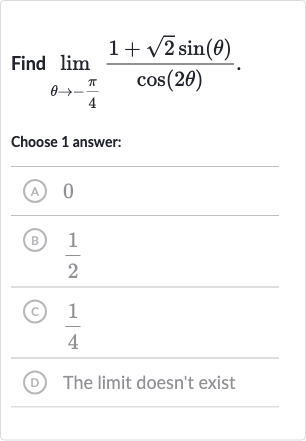Full solution
Q. Find .Choose answer:(A) (B) (C) (D) The limit doesn't exist
- Simplify Expression: We are asked to find the limit of the function as approaches . To do this, we will first simplify the expression if possible and then substitute the value of into the simplified expression.
- Apply Double Angle Formula: Let's recall the double angle formula for cosine: . We can also use the Pythagorean identity to rewrite as or . Since we have a square root of multiplying the sine function in the numerator, it might be beneficial to use the form for to potentially simplify the expression.
- Substitute Theta Value: Now, let's rewrite the limit using the chosen form of the double angle formula: .
- Perform Operations: Next, we substitute into the sine function. We know that . Let's substitute this value into the expression:.
- Simplify Further: Simplify the expression by performing the operations inside the limit: .
- Identify Indeterminate Form: Further simplification gives us: .
- Confirm Limit: We now have in the numerator and in the denominator, which is an indeterminate form. This means we cannot directly evaluate the limit by substitution. We need to find another way to evaluate the limit, possibly by factoring or using L'Hôpital's rule. However, since the numerator is already , the limit of the function as approaches is , provided that the denominator is not also after simplification.
- Confirm Limit: We now have in the numerator and in the denominator, which is an indeterminate form. This means we cannot directly evaluate the limit by substitution. We need to find another way to evaluate the limit, possibly by factoring or using L'Hôpital's rule. However, since the numerator is already , the limit of the function as theta approaches is , provided that the denominator is not also after simplification.Looking back at the denominator, we see that after simplification, it is indeed , which confirms the indeterminate form . However, since the numerator is regardless of the value of theta, and the denominator is not always for values of theta near , the limit of the function as theta approaches is .
More problems from Domain and range
QuestionGet tutor help

